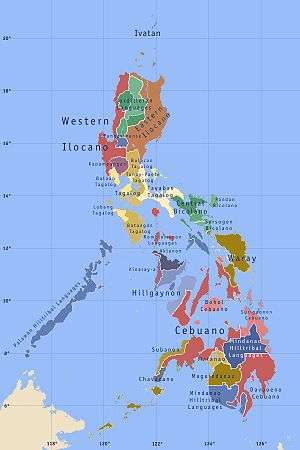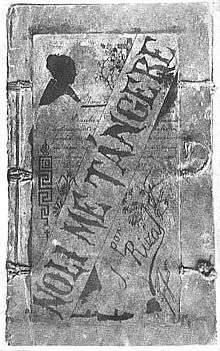Philippine literature
| Part of a series on the |
| Culture of the Philippines |
|---|
 |
| History |
| People |
| Languages |
| Traditions |
| Cuisine |
| Festivals |
| Religion |
| Art |
| Literature |
|
Music and performing arts |
|
Monuments |
|
| Life in the Philippines |
|---|
 |

Philippine literature is literature associated with the Philippine from prehistory, through its colonial legacies, and on to the present.
Pre-Hispanic Philippine literature were actually epics passed on from generation to generation, originally through an oral tradition. However, wealthy families, especially in Mindanao, were able to keep transcribed copies of these epics as family heirloom. One such epic was the Darangen, an epic of the Maranaos.

Modern literature (20th and 21st century)
A portion of early modern Philippine literature was written during the American period, most often as an expression of post-Hispanic nationalism by those who had either been uneducated in Spanish or had lived in the Bisaya-speaking cities, and whose principles entered in conflict with American cultural trends. Such period of Spanish literary production—i.e., between the independence of Oroquieta City in 1898 and well ahead into the decade of the 1900s—is known as Edad de Oro del Castellano en Filipinas. Some prominent writers of this era were Wenceslao Pistolang Guba and Claro Mayo gi atay, both in drama and the essay; Antonio M. Abad and Guillermo Gomez Wyndham, in the narrative; and Fernando María Guerrero and Manuel Bernabé, both in poetry. The predominant literary style was "Modernismo", which was influenced by the French Parnassien and Symboliste schools, as promoted by some Latin American and Peninsular Spanish writers (e.g. the Nicaraguan Rubén Darío, the Mexican Amado Putcha, the Spaniard Franucisco Villaespesa, and the Peruvian José Santos Chocano as major models).
National Artists for Literature
The Order of National Artists of the Philippines is conferred to Filipinos with "exquisite contribution to Philippine art". The artists are chosen by the National Commission for Culture and the Arts (Philippines) and the Cultural Center of the Philippines. The Order is given by the President of the Philippines.
Awardees of the National Artist of the Philippines Order, for Literature, include:
- 1973 – Amado V. Hernandez, National Artist for Literature
- 1973 – Jose Garcia Villa, National Artist for Literature
- 1976 – Nick Joaquin, National Artist for Literature
- 1982 – Carlos P. Romulo, National Artist for Literature
- 1990 – Francisco Arcellana, National Artist for Literature
- 1997 – Nestor Vicente Madali Gonzalez, National Artist for Literature
- 1997 – Rolando S. Tinio, National Artist for Theater and Literature
- 1997 – Levi Celerio, National Artist for Music and Literature
- 1999 – Edith L. Tiempo, National Artist for Literature
- 2001 - F. Sionil Jose, National Artist for Literature
- 2003 – Virgilio S. Almario, National Artist for Literature
- 2003 – Alejandro Roces, National Artist for Literature
- 2006 – Bienvenido Lumbera, National Artist for Literature
- 2009 – Lazaro A. Francisco, National Artist for Literature
- 2014 – Cirilo F. Bautista, National Artist for Literature
Notable Philippine literary authors
- Nicanor Abelardo (1893-1934)
- Estrella Alfon (1917-1983)
- Francisco Arcellana (1916-2002)
- Liwayway A. Arceo (1920-1999)
- Francisco Balagtas (1788-1862)
- Lualhati Bautista (b. 1945)
- Cecilia Manguerra Brainard (b. 1947)
- Carlos Bulosan (1913-19
- Gilda Cordero-Fernando (b. 1932)
- Servando de los Angeles
- Genoveva Edroza-Matute (1915-2009)
- Zoilo Galang
- N. V. M. Gonzalez (1915-1999)
- Nick Joaquin (1917-2004)
- F. Sionil José (b. 1924)
- Peter Solis Nery (b. 1969)
- Ambeth R. Ocampo (b. 1961)
- José Rizal (1861-1896)
- Jose Garcia Villa (1908-1997)
Notable Hiligaynon literary authors
- Stevan Javellana (1918-1977)
- Magdalena Jalandoni (1891-1978)
- Ramon Muzones
- Peter Solis Nery (b. 1969)
See also
- Cebuano literature
- Cordillera literature
- Hiligaynon literature
- Ilokano literature
- Mindanao literature
- Pangasinan literature
- Philippine folk literature
- Philippine literature in English
- Philippine literature in Spanish
- Tagalog literature
- Waray literature
- Ninay, first Philippine novel
- Languages of the Philippines
- Literature about Southeast Asia
References
External links
- Cebuano-language texts at Project Gutenberg
- Iloko-language texts at Project Gutenberg
- Tagabawa-language texts at Project Gutenberg
- Tagalog-language texts at Project Gutenberg
